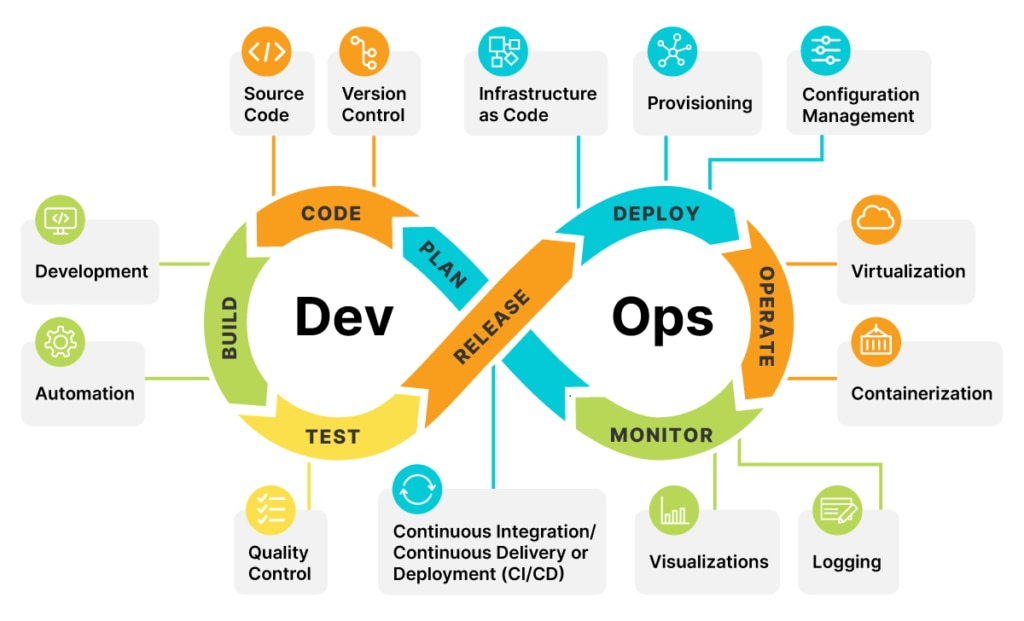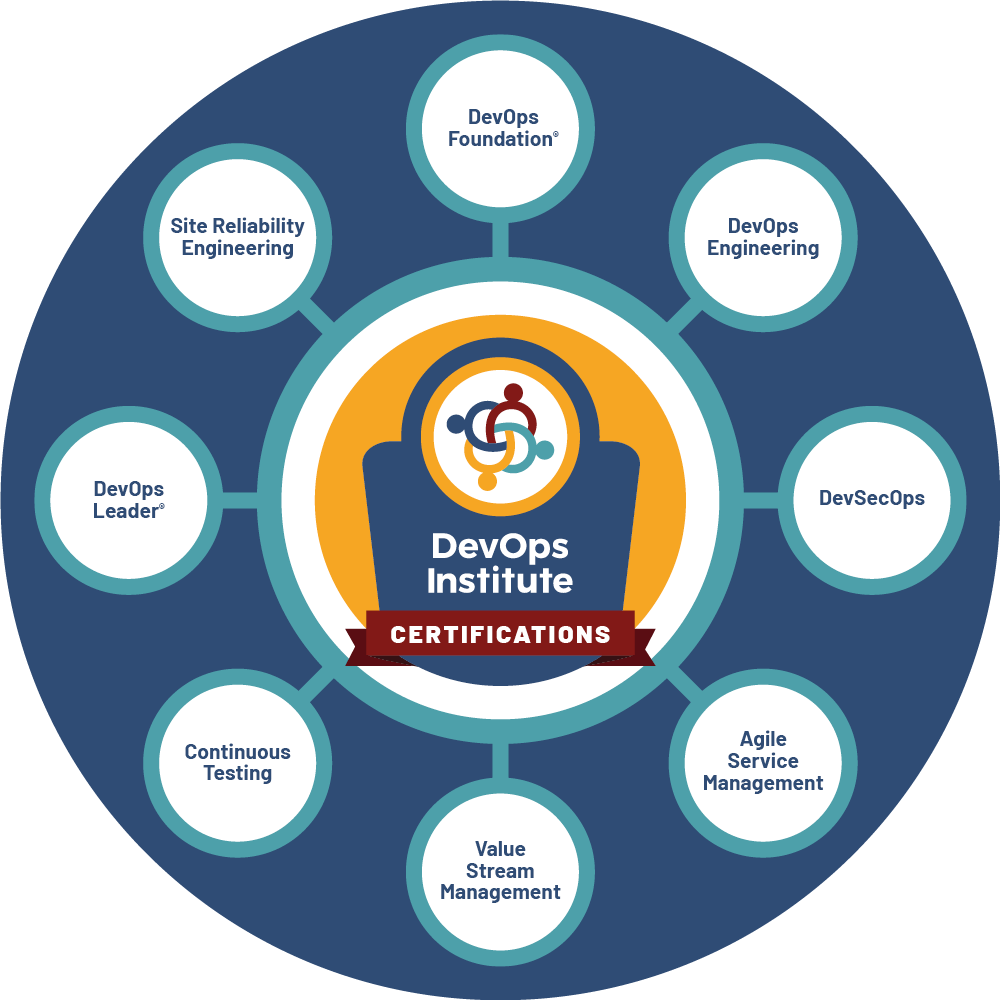Table of Contents

In the ever-evolving landscape of software development where speed, reliability, Power of Automation, and continuous improvement are essential, the DevOps methodology has emerged as a guiding light. DevOps, short for “development” and “operations”, is a collaborative approach that aims to break down the traditional barriers between software development and IT operations teams. In short, DevOps is not just a set of practices but a cultural shift that emphasizes collaboration, automation, and efficiency. Before we get into the specific tools that drive DevOps, let’s further define what it is and why it’s changing up the world of software development.
Demystifying DevOps
DevOps is a philosophy that addresses the challenges posed by traditional software development. Historically, developers and operations teams worked in separate silos, leading to communication gaps, slow release cycles, and a lack of accountability. DevOps aims to bridge this divide by fostering collaboration, communication, and integration between these two critical teams.
At its core, DevOps seeks to achieve a seamless, automated workflow that spans from code development to testing, deployment, and monitoring. This is achieved by incorporating automation, continuous integration (CI), continuous delivery (CD) into the development process. Before we look closer at specific tools Power of Automation and practices, let’s go through some of the main pillars of DevOps:
-
- Automation: acting as the heart of DevOps, automation is the point from which all DevOps principles pivot. It is the art of leveraging technology to execute manual, repetitive tasks with precision, speed, and consistency, reducing human error and increasing efficiency. Automation permeates every stage of the software development cycle, from code creation and testing to deployment and monitoring. By automating routine tasks, developers and operations teams can focus on more strategic and innovative endeavors that propel their organization forward.
-
- Continuous improvement: emphasizing the ongoing enhancement of processes, tools, and methodologies, DevOps teams Power of Automation regularly assess their workflows, seeking opportunities to refine and optimize their practices.
-
- Flexibility and agility: responding successfully to the fast-paced technological landscape is a fundamental pillar of DevOps. By prioritizing adaptability, teams react promptly to changing requirements, market shifts, and evolving customer needs.
-
- Collaboration: dismantling traditional barriers between development teams, DevOps distinguishes itself through its emphasis on increased collaboration. By fostering a culture of shared responsibility and open communication, teams work toward common goals, share insights, and jointly resolve challenges.
Key benefits of DevOps
It’s no secret that DevOps has become a highly sought-after set of practices. By adopting DevOps principles, organizations can increase the efficiency and reliability of their digital products. Let’s go through some of the specific benefits that DevOps brings to both companies and teams:
-
- Faster time-to-market: DevOps streamlines the development process, enabling faster delivery of features and updates to customers, giving companies a competitive edge.
-
- Improved collaboration: DevOps fosters cross-functional collaboration between development, operations, and other teams reducing misunderstandings and fostering a shared sense of ownership.
-
- Enhanced quality: DevOps ensures that software is thoroughly tested by implementing automated Power of Automation testing and continuous monitoring systems, which reduce the likelihood of bugs and glitches reaching delivery.
-
- Increased reliability: DevOps practices like CI/CD and infrastructure as code result in consistent and reliable deployments, reducing system failures and downtime.
-
- Efficient resource utilization: DevOps automation allows teams to optimize resource allocation, saving time and costs by reducing manual interventions.
-
- Scalability: DevOps enables applications to be easily scaled up or down based on demand, ensuring smooth performance during peak usage periods.
-
- Innovation and experimentation: DevOps minimizes risks associated with software releases by addressing issues early on in the development processes. This creates a safer environment that provides the opportunity to test new ideas and features.
DevOps Practices and Tools
Now, the moment you’ve been waiting for: the fusion of practices and tools that comprise DevOps has become an essential driver of collaboration, automation, and continuous growth for the software development industry. Let’s dive deep into some of the most prevalent DevOps practices and the tools that underpin their success:
DevOps automation tools
-
- Continuous integration (CI): CI accelerates development cycles and verifies code quality. Tools such as Jenkins, Travis CI, and CircleCI automate the process of merging code changes from multiple developers into a shared repository. These tools then trigger automated tests to catch any glitches early in the development process.
-
- Continuous delivery/deployment (CD): CD extends the CI process by automating the deployment of successfully tested code changes to various environments, such as staging or production. DevOps deployment tools like Ansible and Puppet automate configuration management and ensure a consistent deployment environment, and Kubernetes plays a significant role in orchestrating the scaling of containerized applications. CD enables teams to quickly release new features without compromising reliability.
-
- Infrastructure as Code (IaC): IaC brings automation to infrastructure management. Tools such as Terraform and AWS CloudFormation empower developers to define and provision infrastructure resources using code. This approach ensures that infrastructure configurations Power of Automation are consistent across different environments and reduces the risk of discrepancies.
-
- Monitoring and alerting: automated DevOps monitoring tools are essential for maintaining the health and performance of applications in production. Prometheus is an open-source system that collects metrics from various sources, providing insights into application performance and resource utilization. Grafana, a complementary tool, offers visualization and alerting capabilities, enabling teams to create informative dashboards that track performance data. Together these applications automatically trigger alerts when specific metrics fall below acceptable thresholds, allowing for swift issue resolution.
Additional DevOps tools and practices
-
- Version control: by leveraging robust version control systems like Git, DevOps teams can work together, track changes, and manage distinct software versions. Git allows developers to create branches for new features, experiment Power of Automation with changes, and merge their work back into the main codebase. Platforms like GitHub, GitLab, and Bitbucket enhance collaboration by providing web-based interfaces for managing repositories and reviewing code.
-
- Microservices architecture: by breaking down applications into Power of Automation smaller, loosely coupled services, DevOps teams can operate more independently, fostering faster development cycles. Docker containers play a pivotal role in microservices by encapsulating each Power of Automation service alongside its dependencies, ensuring consistency across different environments.
-
- DevSecOps: by including security maintenance into the development realm, DevOps security tools have cropped up to support each aspect of the development process. Under the umbrella of DevSecOps, tools like SonarQube assist in identifying code vulnerabilities and quality issues. OpenVAS is a widely used tool for vulnerability scanning, ensuring that applications are assessed for potential security weaknesses.
-
- Collaboration methods: by employing tools like Slack and Microsoft Teams, DevOps practitioners are able to streamline communication. These platforms facilitate real-time messaging, file sharing, and integration with other tools for DevOps, allowing teams to remain informed. Utilizing these methods promotes transparency and fosters overall project understanding.know more about these practices in this link: https://www.atlassian.com/

Exploring DevOps Tool Certifications
Now that we’ve explored some of the best DevOps tools and methods, let’s discuss how to master them. DevOps tool certifications Power of Automation serve as beacons of expertise, showing employers that you are well-versed in the complexities of modern software delivery. Let’s delve into some common DevOps tool certifications:
-
- Certified Jenkins Engineer: this certification validates expertise in Jenkins, a widely used CI/CD tool. It covers topics such as setting up pipelines, integrating version control systems, and automating deployments.
-
- Docker Certified Associate: this certification assesses skills in containerization technology. It covers creating and managing containers, configuring images, and orchestrating applications using Docker Swarm.
-
- The Power of Automation in Modern DevOps Practices: automation is key to efficient DevOps. It streamlines processes, reduces human error, and ensures consistency across development and deployment pipelines.
-
- Certified Kubernetes Administrator (CKA): this certification focuses Power of Automation on Kubernetes administration, evaluating proficiency in deploying, maintaining, and troubleshooting Kubernetes clusters.
-
- Certified Ansible Automation Engineer (Red Hat Certification): this certification confirms competence in automating infrastructure provisioning, configuration management, and application deployment using Ansible.
-
- AWS Certified DevOps Engineer: this certification proves proficiency in DevOps practices on the Amazon Web Services platform. Those seeking certification should be well-versed in AWS DevOps tools such as CodeStar, CodeDeploy, CodePipeline, and CloudFormation.
-
- Microsoft Certified: DevOps Engineer Expert: this certification demonstrates mastery over DevOps practices on the Microsoft Azure platform. To gain this certification, one should be familiar with Microsoft Azure DevOps tools, such as Azure Resource Manager (ARM), Pipelines, and Boards.
-
- click here to stay in touch with vyneei blogs : https://vyneei.com/news/
-
Exploring DevOps Tool Certifications
Now that we’ve explored some of the best DevOps tools and methods, let’s discuss how to master them. DevOps tool certifications Power of Automation serve as beacons of expertise, showing employers that you are well-versed in the complexities of modern software delivery. Let’s delve into some common DevOps tool certifications:
- Certified Jenkins Engineer: this certification validates expertise in Jenkins, a widely used CI/CD tool. It covers topics such as setting up pipelines, integrating version control systems, and automating deployments.
-
- Docker Certified Associate: this certification assesses skills in containerization technology. It covers creating and managing containers, configuring images, and orchestrating applications using Docker Swarm.
-
- The Power of Automation in Modern DevOps Practices: automation is key to efficient DevOps. It streamlines processes, reduces human error, and ensures consistency across development and deployment pipelines
What is DevOps?
What are the key pillars of DevOps?
Continuous Improvement: Constant evaluation and optimization of processes and tools.
Flexibility and Agility: Adapting to the fast-paced technological environment.
Collaboration: Fostering open communication and shared responsibility between teams.
How does DevOps improve software development?



